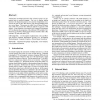Free Online Productivity Tools
i2Speak
i2Symbol
i2OCR
iTex2Img
iWeb2Print
iWeb2Shot
i2Type
iPdf2Split
iPdf2Merge
i2Bopomofo
i2Arabic
i2Style
i2Image
i2PDF
iLatex2Rtf
Sci2ools
VISUALIZATION
2002
IEEE
2002
IEEE
CPR - Curved Planar Reformation
Visualization of tubular structures such as blood vessels is an important topic in medical imaging. One way to display tubular structures for diagnostic purposes is to generate longitudinal crosssections in order to show their lumen, wall, and surrounding tissue in a curved plane. This process is called Curved Planar Reformation (CPR). We present three different methods to generate CPR images. A tube-phantom was scanned with Computed Tomography (CT) to illustrate the properties of the different CPR methods. Furthermore we introduce enhancements to these methods: thick-CPR, rotating-CPR and multi-path-CPR. CR Categories: J.3.2 [Computer Applications]: Life and Medical Sciences—Medical Information Systems I.3.3 [Computing Methodologies]: Computer Graphics—Picture/Image Generation
Curved Planar Reformation | Longitudinal Crosssections | Tubular Structures | Visualization | VISUALIZATION 2002 |
| Added | 16 Jul 2010 |
| Updated | 16 Jul 2010 |
| Type | Conference |
| Year | 2002 |
| Where | VISUALIZATION |
| Authors | Armin Kanitsar, Dominik Fleischmann, Rainer Wegenkittl, Petr Felkel, Eduard Gröller |
Comments (0)

